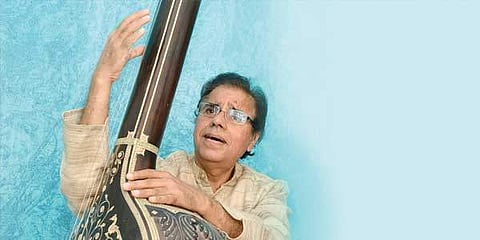

Sitting behind the Tamburu, Father Joseph Palackal plays the alap in 'Raga Asavari' from the Hindustani tradition at his brother’s home in Kochi. Later, he launches into the Christian epic song, ‘Puthen Pana’. His voice is melodious.
“The ‘Puthen Pana’ was written by Jesuit priest Johann Ernst Hanxleden from Germany in 1721. He was known as Arnos Pathiri,” says Fr Palackal, who is based at the St. Stanislaus Kostka Church at Maspeth in New York. “He came to Kerala as a 19-year-old, became a priest, and learnt Malayalam. The Pana is a narration of Biblical events.”
It became a part of the Christian experience as at that time they did not have the Bible in the local language. Fr Palackal, who has been doing research on the Christian musical legacy in India, especially in the Syro-Malabar church of Kerala for years, says, “The Pana was in Syriac and only the priest knew how to read them. So, people learned the poem by heart. My mother could narrate the entire Pana in a more than two-hour sitting.”
Syriac is a dialect of the Aramaic language, the mother tongue of Jesus. The music came from West Asia hundreds of years ago and mingled with the local culture.
“The music in Indian Christianity is multi-faceted,” he says. “So, the versions in the North-east are different from what we hear in Bihar, Uttar Pradesh and Goa, which has the Portuguese influence. Christians in Kerala have two major systems—the one with the Syro-Malabar Church, to which I belong, and the other with the Syrian Orthodox-Jacobite churches.”
Until the 16th century, songs were sung without instruments. “It was the Portuguese who introduced Violin, Harmonium, Bass Drum and Bugle,” says Fr Palackal. But everything changed in 1962, when the church authorities gave permission for songs to be sung in vernacular languages. “It was a watershed,” says Father. “Syriac literacy diminished, even among the priests. But the Jacobite churches retained most of the Syriac language.”
However, in the Syro-Malabar church, the people resorted to film-style music. “Modern musical instruments, like the keyboard, have been added. But it has lost its essence,” he says
Fr Palackal is trying his best to preserve the memories and the melodies. He comes to Kerala every year to meet people who are able to capture the melodies of the Syriac songs. “But the time is running out,” he says. “Most of the stalwarts are losing their memory or passing away.”
Fr Palackal has uploaded many recorded songs with notes on YouTube as part of the Aramaic Project. He has even started working on a digital encyclopaedia of Syriac Chants of the Syro-Malabar Church, and a directory of Christian songs in India. The priest, who has written an article on the subject in the just-published Oxford Handbook of Music and World Christianities, says, “I am trying to do my bit to preserve the history.”